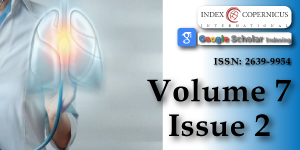Cardiac Tamponade as the Cause of Pulmonary Edema: Case Report
Main Article Content
Abstract
Introduction: Cardiac tamponade is an emergency syndrome that requires fast diagnosis and treatment; otherwise patient follows obstructive shock and cardiac arrest.
Case report: A 70-year-old female was brought to the emergency department with hypoxemia. She had a history of progressive dyspnea over the past three weeks. Past medical history includes smoking. On physical examination: tachypnea, hypoxemia (SaO2 89%), jugular venous distention, arterial pressure 220/100 mmHg, heart rate rhythmic of 82 bpm. On pulmonary auscultation: diffuse and bilateral crackles. Lung ultrasound showed a bilateral B line and the echocardiogram demonstrated a pericardial effusion with signs of tamponade. A pericardiocentesis evacuated 620 ml of hemorrhagic fluid and the patient was transferred to the intensive care unit, hemodynamically stable, with SaO2 95%. At the ICU the echocardiogram, showed resolution of the cardiac tamponade and a tumor adhered to the lateral wall of the left ventricle. Chest CT demonstrated: a left lung tumor, infiltrating the pericardial sac. A pericardium biopsy demonstrated undifferentiated carcinoma.
Discussion: Cardiac tamponade diagnosis requires a high level of suspicion. Respiratory failure, chest pain, and shock, observed in cardiac tamponade, are also present in different diseases. The most common finding of cardiac tamponade is dyspnea (78% of cases). Our patient had dyspnea due to pulmonary edema, secondary to left ventricle diastolic dysfunction caused by the tamponade. A bedside echocardiogram made the diagnosis of cardiac tamponade and guided the effective pericardiocentesis.
Conclusion: Cardiac tamponade must be suspected in all cases of acute dyspnea. Echocardiogram is the method of choice for the diagnosis and for guiding the pericardiocentesis.
Article Details
Copyright (c) 2023 Lima E.

This work is licensed under a Creative Commons Attribution 4.0 International License.
Demetriades D. Cardiac wounds. Experience with 70 patients. Ann Surg. 1986 Mar;203(3):315-7. doi: 10.1097/00000658-198603000-00018. PMID: 3954485; PMCID: PMC1251098.
Scheinin SA, Sosa-Herrera J. Case report: cardiac tamponade resembling an acute myocardial infarction as the initial manifestation of metastatic pericardial adenocarcinoma. Methodist Debakey Cardiovasc J. 2014 Apr-Jun;10(2):124-8. doi: 10.14797/mdcj-10-2-124. PMID: 25114766; PMCID: PMC4117332.
Yarlagadda C. Cardiac tamponade: practice, essentials, background and pathophysiology. http://emedicine.medscape.com/article/152083- overview#showall
Stashko E, Meer JM. Cardiac Tamponade. National Library of Medicine. https://www.ncbi.nlm.nih.gov/books/NBK431090/.
Martins QC, Juliano C. Pericardial Effusion and Cardiac Tamponade: Etiology and Evolution in the Contemporary Era. Int J Cardiovasc Sci. 25/out/2021. 34(5 supl 1) 24-31.
Bottinor W, Fronk D, Sadruddin S, Foster H, Patel N, Prinz A, Jovin IS. Acute Cardiac Tamponade in a 58-Year-Old Male with Poststreptococcal Glomerulonephritis. Methodist Debakey Cardiovasc J. 2016 Sep;12(3):175-176. doi: 10.14797/mdcj-12-3-175. PMID: 27826373; PMCID: PMC5098576.
Chong HH, Plotnick GD. Pericardial effusion and tamponade: evaluation, imaging modalities, and management. Compr Ther. 1995 Jul;21(7):378-85. PMID: 7554815.
Lima E. Cardiac Tamponade as Cause of Respiratory Distress and Cardiac Arrest. J.Clin Case Stu. 2018; 3(3): dx.doi.org/10.16966/24714925.174
Petcu DP, Petcu C, Popescu CF, Bătăiosu C, Alexandru D. Clinical and cytological correlations in pericardial effusions with cardiac tamponade. Rom J Morphol Embryol. 2009;50(2):251-6. PMID: 19434319.
Cornily JC, Pennec PY, Castellant P, Bezon E, Le Gal G, Gilard M, Jobic Y, Boschat J, Blanc JJ. Cardiac tamponade in medical patients: a 10-year follow-up survey. Cardiology. 2008;111(3):197-201. doi: 10.1159/000121604. Epub 2008 Apr 25. PMID: 18434725.
Barra LD. Acute cardiac tamponade: a brief review. Medical Journal of Minas Gerais. 2008; 18(3 supl 4): S37-S40.





